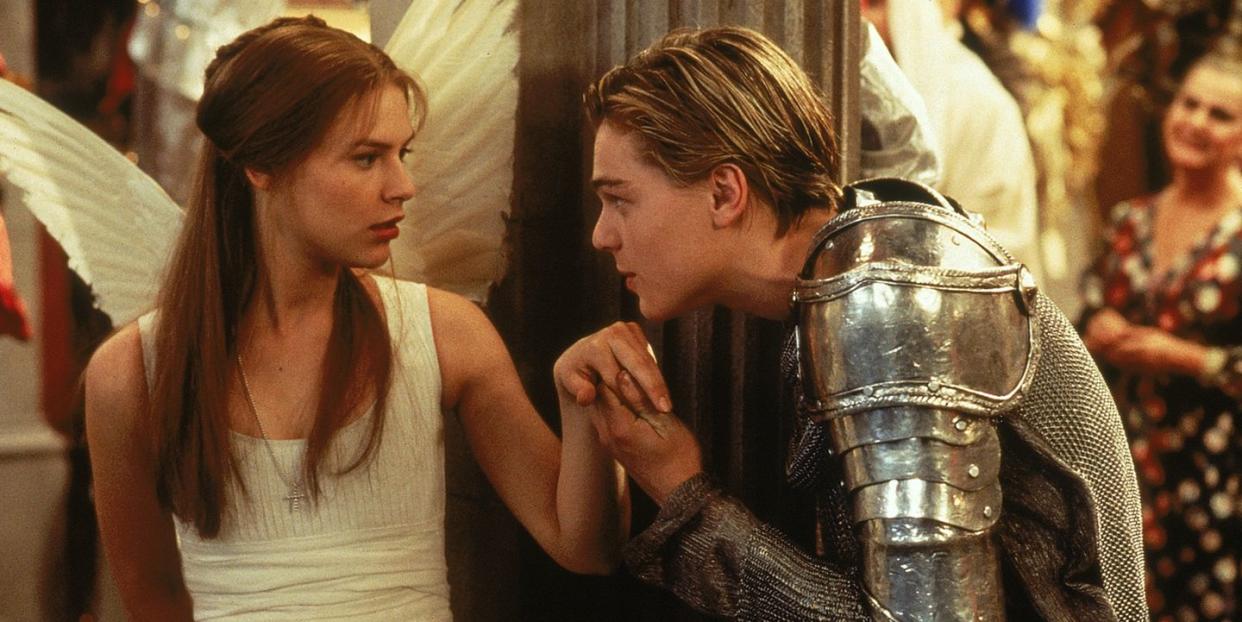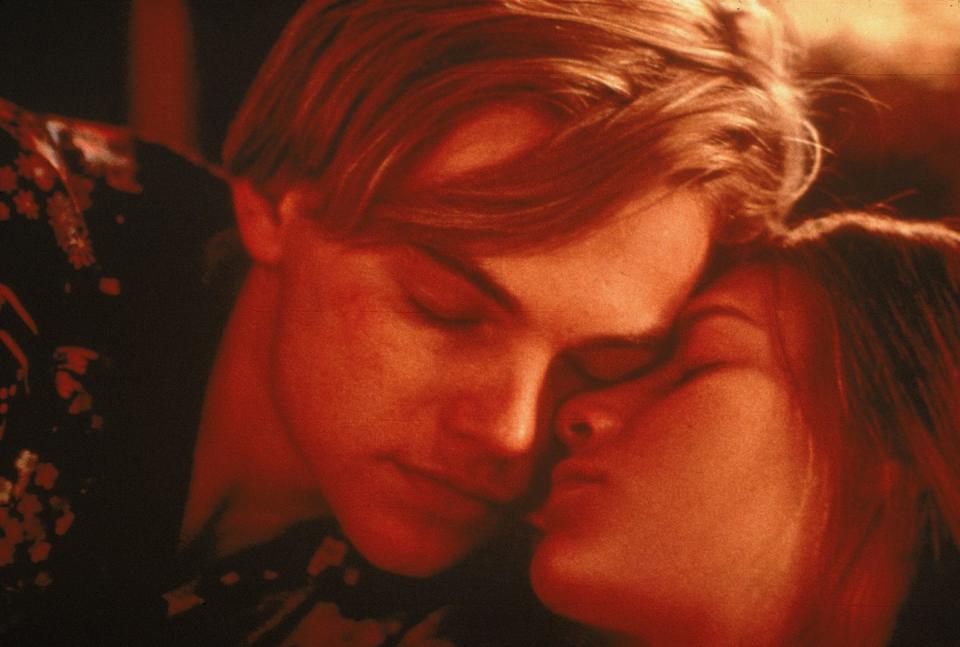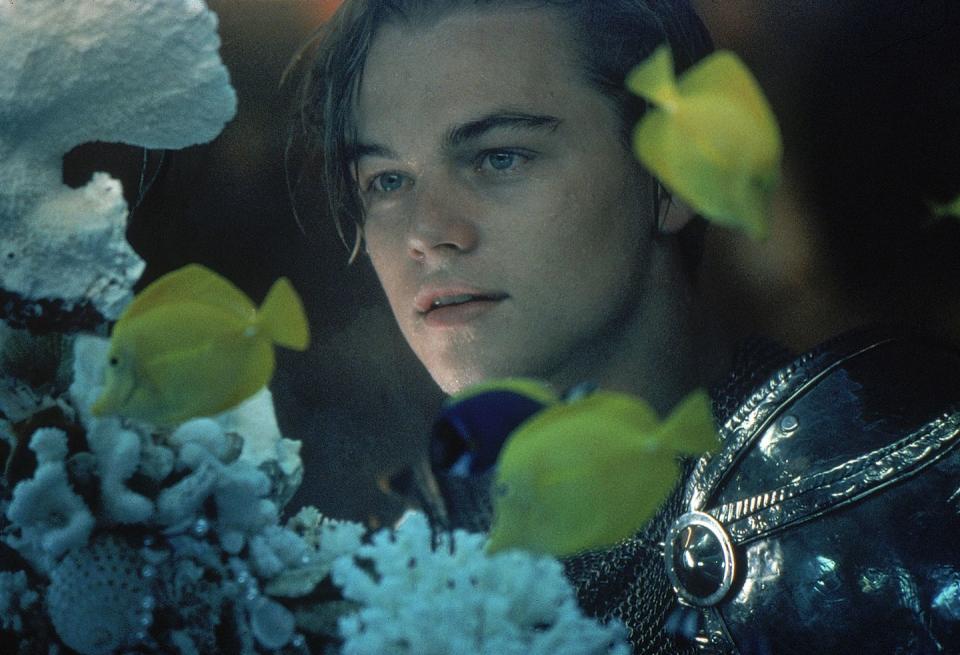Why 'Romeo + Juliet' is such an enduring cultural classic

Presenting the Best Supporting Actress category at this year’s Academy Awards, Brad Pitt was tasked with explaining how each nominee fell in love with movies. "For Amanda Seyfried, it was the film version of Romeo + Juliet. The Leo [DiCaprio] version," he read, cheekily adding, "Amanda, me too" to warm chuckles from the crowd.
Two months later, for the second series of Feel Good, the show’s creator Mae Martin paid homage to the film’s iconic meet-cute, dressing up as DiCaprio’s knight in shining armour while Des’ree’s soothing ballad ‘Kissing You’ plays on the soundtrack. And just a few weeks ago, Rachel Zegler (the star of Steven Spielberg’s upcoming West Side Story remake) tweeted a picture of herself smiling sweetly in Juliet’s angel wings.

Baz Luhrmann’s Romeo + Juliet, which turns 25 this month, was a cultural reset before the term was popularised, indelibly printing its stamp on our collective imaginations. Referenced in Halloween costumes and Euphoria episodes to this day, his fizzing, sparking, pistol-toting adaptation blazed across our screens and blasted the dust off Shakespeare.
This outré, punk approach to the 16th-century tragedy was largely met with critical derision in 1996. In his two-star review, the film journalist Roger Ebert sniffed that “this production was a very bad idea” and it would “dismay any lover of Shakespeare”. He is entitled to his opinion, of course, but I’d venture that this version was not intended for him (and, indeed, the fact that the movie went on to snag the number-one spot at the US box office upon release proves that it carried plenty of appeal to other audiences).
Luhrmann translates Romeo & Juliet for the MTV generation and updates its outmoded iconography, thereby giving himself space to situate the 400-year-old play firmly in the here and now. He creates an eye-popping, neon-washed world where swords become guns, prologists become TV newsreaders and messengers are Fedex delivery drivers. The otherwise tricky Elizabethan dialogue is never an impediment to understanding because the director visualises the action so meticulously from the outset, denoting the characters and their relationships to one another with on-screen text, and doubling back to deliver the opening sonnet more slowly for a second time to ensure we have fully grasped the story beats before launching us into the narrative.

Romeo + Juliet is fresh, it’s original, it’s alive. Edited with the frantic energy of a sugar-high toddler, it zips along at adrenalin-jolting speed, stopping off to observe drug-fuelled drag performances and frenzied car chases, petrol-station gun fights and rowdy snooker games. It is a sensory overload of a movie from a film-maker now renowned for such excess – Luhrmann’s follow-up to R+J would be the similarly go-for-broke Moulin Rouge. And yet, the director always knows exactly when to relent his barrelling dynamism. This is, above all, a retelling of the most famous love story ever written, and the film takes care to quieten the noise and slow the pace during Romeo and Juliet’s scenes together.
As the star-crossed lovers, Leonardo DiCaprio and Claire Danes have a smouldering romantic chemistry palpable enough to make any viewer weak at the knees. He looks at her with complete, open-faced adoration and she returns his gaze with shy, pink-cheeked delight. For all the choral Prince covers and billowing Hawaiian shirts, R+J never loses sight of the steadfast passion that drives it and, unlike today’s all but neutered Hollywood movies, possesses an undeniable sexual potency. Desire bounces off the screen in the film, whether it’s Juliet curling her fingers through her husband’s rain-soaked hair or Romeo emerging from an inadvertent swim proposing marriage (that Leo is soaking wet during both these sequences speaks for itself).

The two most pastiched moments in the film – when the lovers steal glimpses of each other through a tropical-fish tank and, later, confirm their relationship status in the Capulet pool – are memorable not only for their daring reinvention of the original (inverting the blocking of the balcony scene is a stroke of genius), but also for how they let us experience the heart-thumping whirlwind of love at first sight. I’ve seen enough limp Romeo & Juliet adaptations to know that this emotional intelligence is a rare commodity.
For me, and the legions of other teenage girls who first saw the film in English class, Romeo + Juliet was quite simply a revelation, an earth-shattering bolt from the blue. It was my defining text at age 13, when I would wake up every day to its soundtrack floating from my alarm clock, wear a spaghetti-strapped cotton dress for weeks on end and, one time, was even wheeled out by the headmaster to quote huge chunks of the play to the school’s Ofsted inspector (which I knew off by heart from my looping viewings of the film). Until that point, I’d never seen a movie like this. It was a volcanic eruption of colour and verve that rewarded me with new nuggets of detail on each rewatch.

Of course, I would be remiss not to mention the primal draw of Romeo + Juliet: one baby-faced Leonardo DiCaprio. The film fully understands its star’s allure. It’s no coincidence that Luhrmann introduces Leo by gliding the camera up his entire body inch by inch while he sits in his oversize Prada suit, writing and smoking in true softboy fashion, backlit by the rising sun that illuminates each individual strand of his golden hair. Shakespeare wrote that Romeo’s “face be better than any man’s” and I like to think he was referring specifically to DiCaprio. Leo leans into his cherubic beauty for the role – which he has been downplaying ever since this short-lived romantic-hero phase of his career – emphasising the awkwardness of his gangly physicality and infusing Romeo with the skittish energy of lovesick youth. Within a filmography of astonishingly realised performances, this is an early standout; we see him transform clumsy impulsivity into mature, ironclad resolve over the course of the movie. It is exquisite to behold.
What makes Romeo + Juliet stand the test of time is that all of its bold artistic choices are in service of a singular creative vision. Luhrmann does not treat the Shakespeare masterwork as a sacred, inert text. Instead – as he recently said on Instagram, where he’s been sharing behind-the-scenes featurettes on the movie – the director “continued to invent and improve” throughout the adaptation process, and remained in “a constant [state of] invention and reinvention”. This glitter bomb of a film explodes the play and builds it back up again with additions and inversions, restaging and reframing that, together, result in a truly unforgettable cinematic experience. In another 25 years, I have no doubt that we’ll cherish Romeo + Juliet just as strongly.
You Might Also Like


